63rd Congress
1913-1914
Only one bill, S.5845, was introduced in the Senate during the 63rd Congress. This organic act treated Puerto Rico as a territory for purposes of the legislation.
Back To Chapter

Web cookies (also called HTTP cookies, browser cookies, or simply cookies) are small pieces of data that websites store on your device (computer, phone, etc.) through your web browser. They are used to remember information about you and your interactions with the site.
Session Management:
Keeping you logged in
Remembering items in a shopping cart
Saving language or theme preferences
Personalization:
Tailoring content or ads based on your previous activity
Tracking & Analytics:
Monitoring browsing behavior for analytics or marketing purposes
Session Cookies:
Temporary; deleted when you close your browser
Used for things like keeping you logged in during a single session
Persistent Cookies:
Stored on your device until they expire or are manually deleted
Used for remembering login credentials, settings, etc.
First-Party Cookies:
Set by the website you're visiting directly
Third-Party Cookies:
Set by other domains (usually advertisers) embedded in the website
Commonly used for tracking across multiple sites
Authentication cookies are a special type of web cookie used to identify and verify a user after they log in to a website or web application.
Once you log in to a site, the server creates an authentication cookie and sends it to your browser. This cookie:
Proves to the website that you're logged in
Prevents you from having to log in again on every page you visit
Can persist across sessions if you select "Remember me"
Typically, it contains:
A unique session ID (not your actual password)
Optional metadata (e.g., expiration time, security flags)
Analytics cookies are cookies used to collect data about how visitors interact with a website. Their primary purpose is to help website owners understand and improve user experience by analyzing things like:
How users navigate the site
Which pages are most/least visited
How long users stay on each page
What device, browser, or location the user is from
Some examples of data analytics cookies may collect:
Page views and time spent on pages
Click paths (how users move from page to page)
Bounce rate (users who leave without interacting)
User demographics (location, language, device)
Referring websites (how users arrived at the site)
Here’s how you can disable cookies in common browsers:
Open Chrome and click the three vertical dots in the top-right corner.
Go to Settings > Privacy and security > Cookies and other site data.
Choose your preferred option:
Block all cookies (not recommended, can break most websites).
Block third-party cookies (can block ads and tracking cookies).
Open Firefox and click the three horizontal lines in the top-right corner.
Go to Settings > Privacy & Security.
Under the Enhanced Tracking Protection section, choose Strict to block most cookies or Custom to manually choose which cookies to block.
Open Safari and click Safari in the top-left corner of the screen.
Go to Preferences > Privacy.
Check Block all cookies to stop all cookies, or select options to block third-party cookies.
Open Edge and click the three horizontal dots in the top-right corner.
Go to Settings > Privacy, search, and services > Cookies and site permissions.
Select your cookie settings from there, including blocking all cookies or blocking third-party cookies.
For Safari on iOS: Go to Settings > Safari > Privacy & Security > Block All Cookies.
For Chrome on Android: Open the app, tap the three dots, go to Settings > Privacy and security > Cookies.
Disabling cookies can make your online experience more difficult. Some websites may not load properly, or you may be logged out frequently. Also, certain features may not work as expected.
Only one bill, S.5845, was introduced in the Senate during the 63rd Congress. This organic act treated Puerto Rico as a territory for purposes of the legislation.
Back To Chapter

Eight bills were introduced during the 86th Congress. Two bills were status legislation, H.R. 1868, contained a provision for independence and the other, H.R. 7003, a provision for statehood. Four bills, H.R. 5926, S.2023, H.R. 9234, and S. 2708 sought to amend the 1952 Constitution by enhancing the “compact” theory. These four bills also affirmed the Commonwealth status. The two remaining bills, S.2396 and H.R. 10266 provided for local referendums on statehood. The 86th Congress did not enact any status changing legislation for Puerto Rico.
Back To Chapter
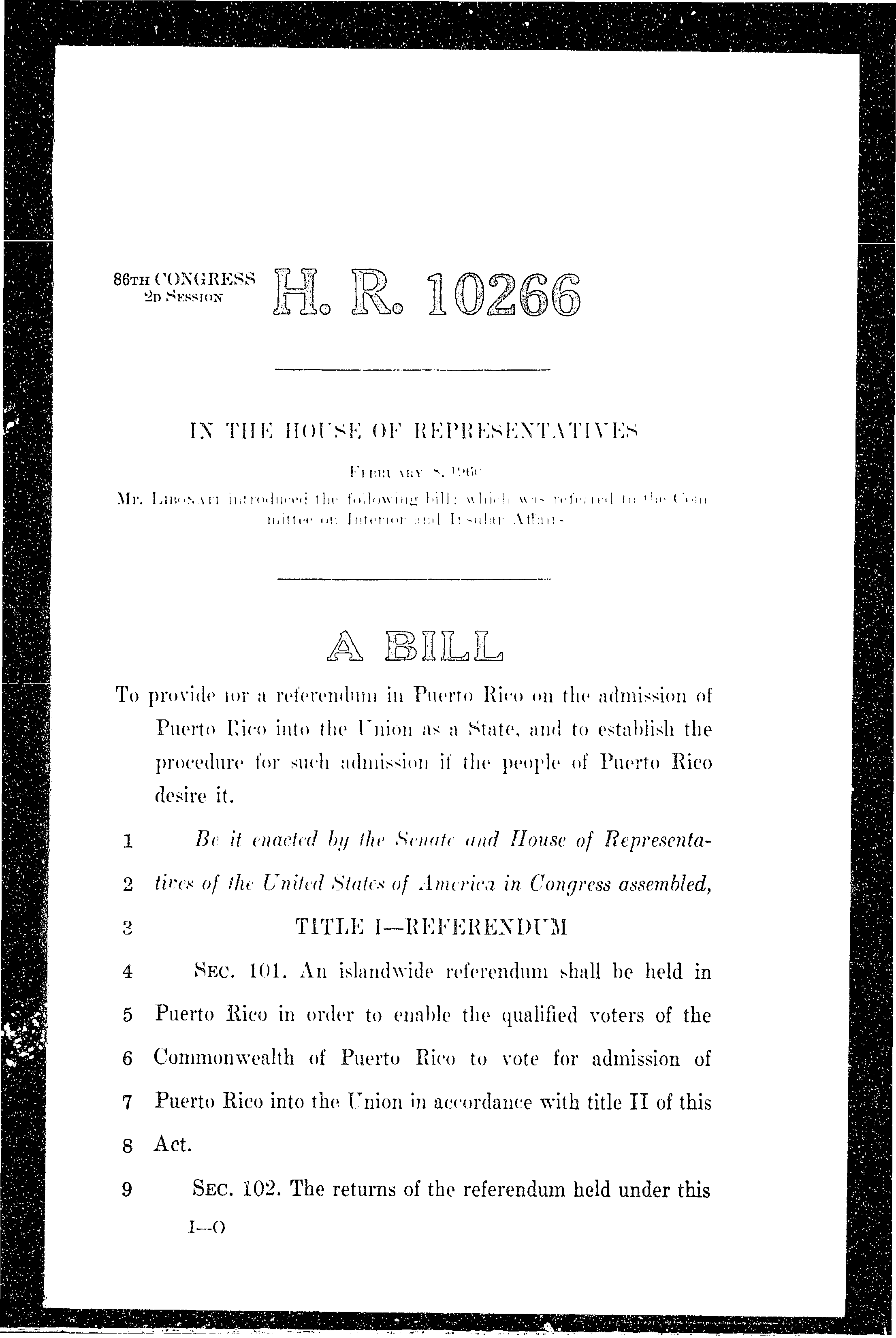
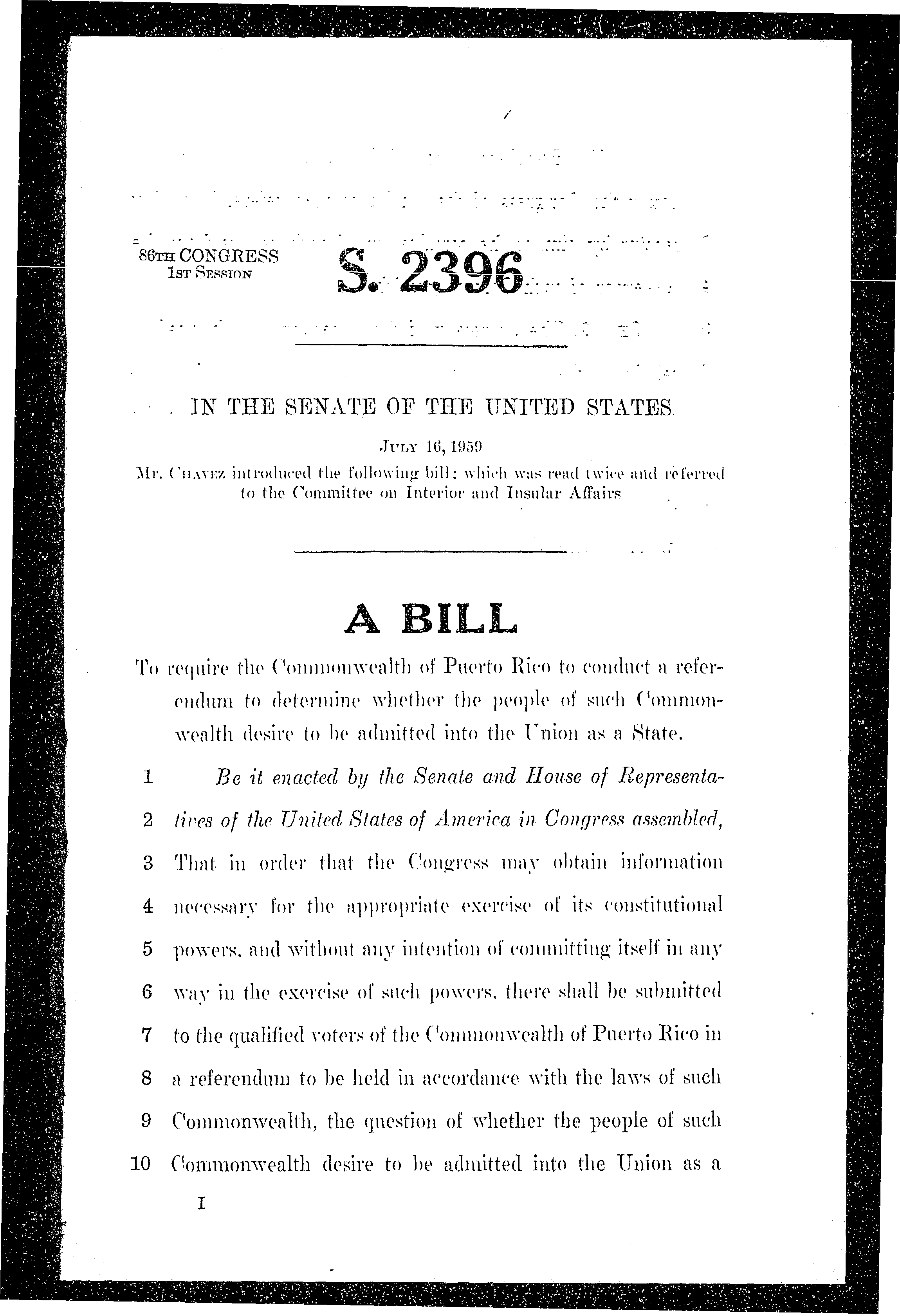
Three bills were introduced during the 105th Congress. Two of these bills, S. 472 and H.R. 856 were plebiscitary legislation and contained multiple options, namely Commonwealth, Statehood, Independence, or Free Association. The remaining bill, S. Res. 279, was a Resolution on the right to self-determination. The 105th Congress did not enact any status changing legislation for Puerto Rico.
Back To Chapter
Only one bill, S.26, was introduced in the Senate during the 64th Congress. This organic act also treated Puerto Rico as a territory for purposes of the legislation.
Back To Chapter
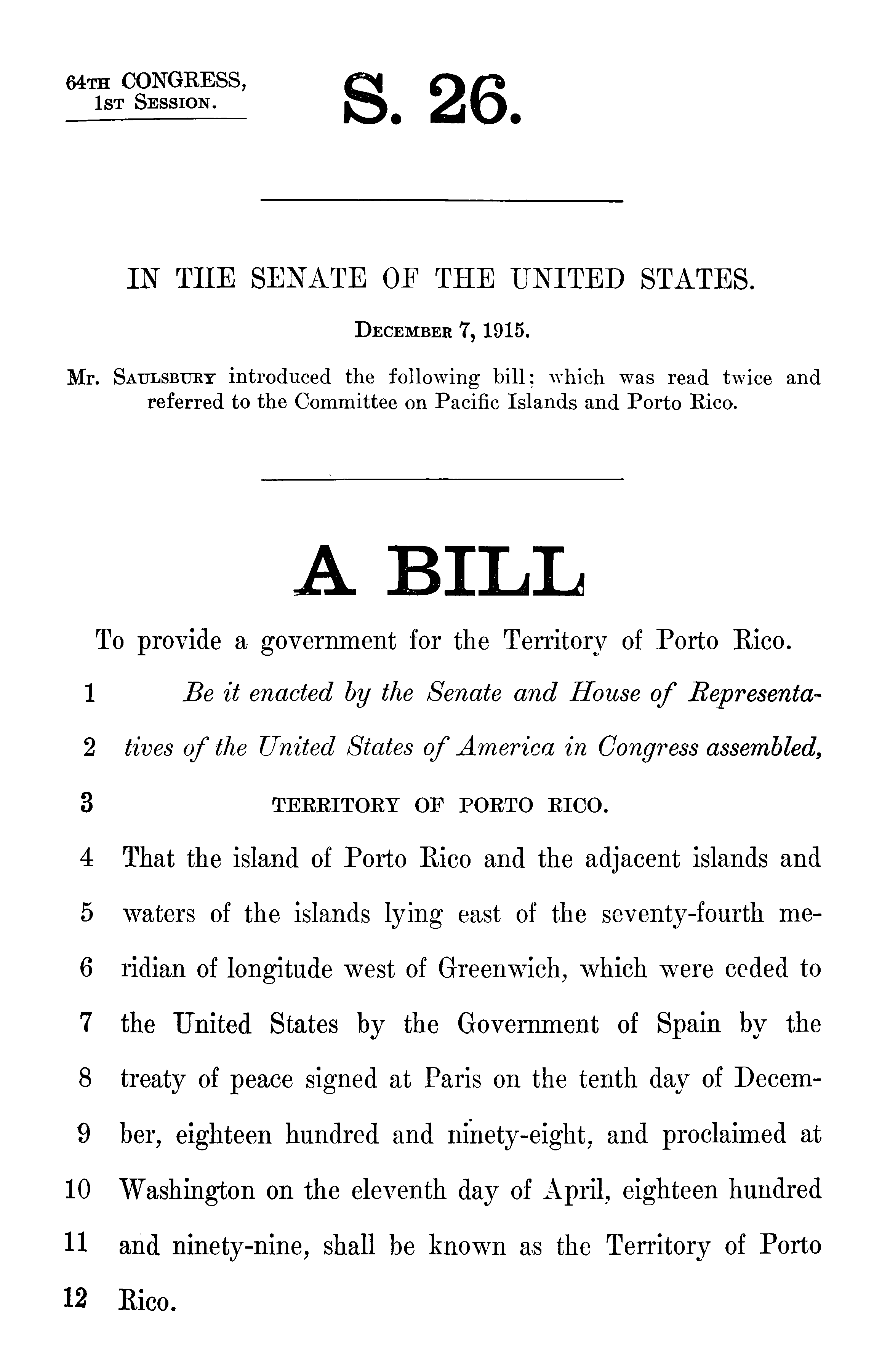
Ten bills were introduced in the 88th Congress. Eight of these bills, H.R. 5945, H.R. 5946, H.R. 5947, H.R. 5948, H.R. 5991, H.R. 6047, H.R. 6076, and H.R. 6083 were plebiscitary bills linked to the creation of a status commission and included multiple status options. They were copies of the same bill but submitted by different lawmakers. One of the remaining bills, H.Res. 549 was a resolution bill. The tenth bill, became Pub. L. 88-271 and affirmed the Commonwealth status.
Back To Chapter

One status bill was introduced in the 106th Congress. H.R. 4751 contained a provision advocating for a Commonwealth/Permanent Union option. The 106th Congress did not enact any status changing legislation for Puerto Rico.
Back To Chapter
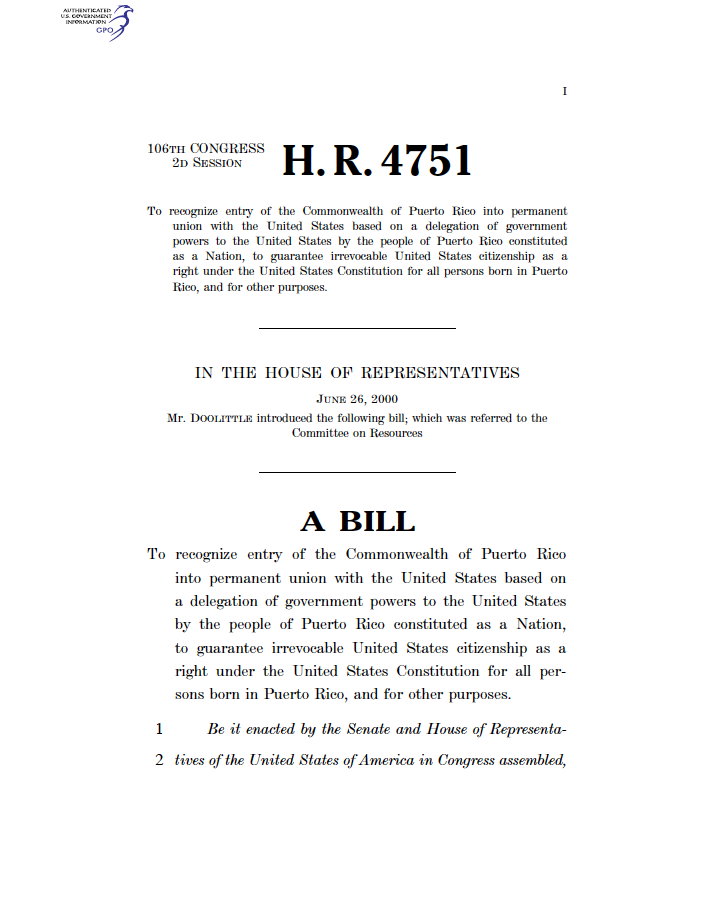
One resolution, namely H.J.Res. 144, was introduced in the House during the 66th Congress. Interestingly, this was the earliest plebiscitary legislation introduced in Congress. H.J.Res. 144 gave Puerto Ricans the option to choose among three status options, namely 1) Independence, 2) Territorial Incorporation and/or 3) the status quo. It is interesting to note that while this legislation did not provide for statehood as an option, it opened the door for this status alternative via territorial incorporation. This legislation did not pass a house vote, nor did it become law.
Back To Chapter
Seven status bills were introduced in the 89th Congress. All of the bills, namely H.R. 17917, H.R. 17920, H.R. 17944, H.R. 17971, H.R. 18009, H.R. 18096, and H.R. 18277 advocated for statehood. The 89th Congress did not enact any status changing legislation for Puerto Rico.
Back To Chapter
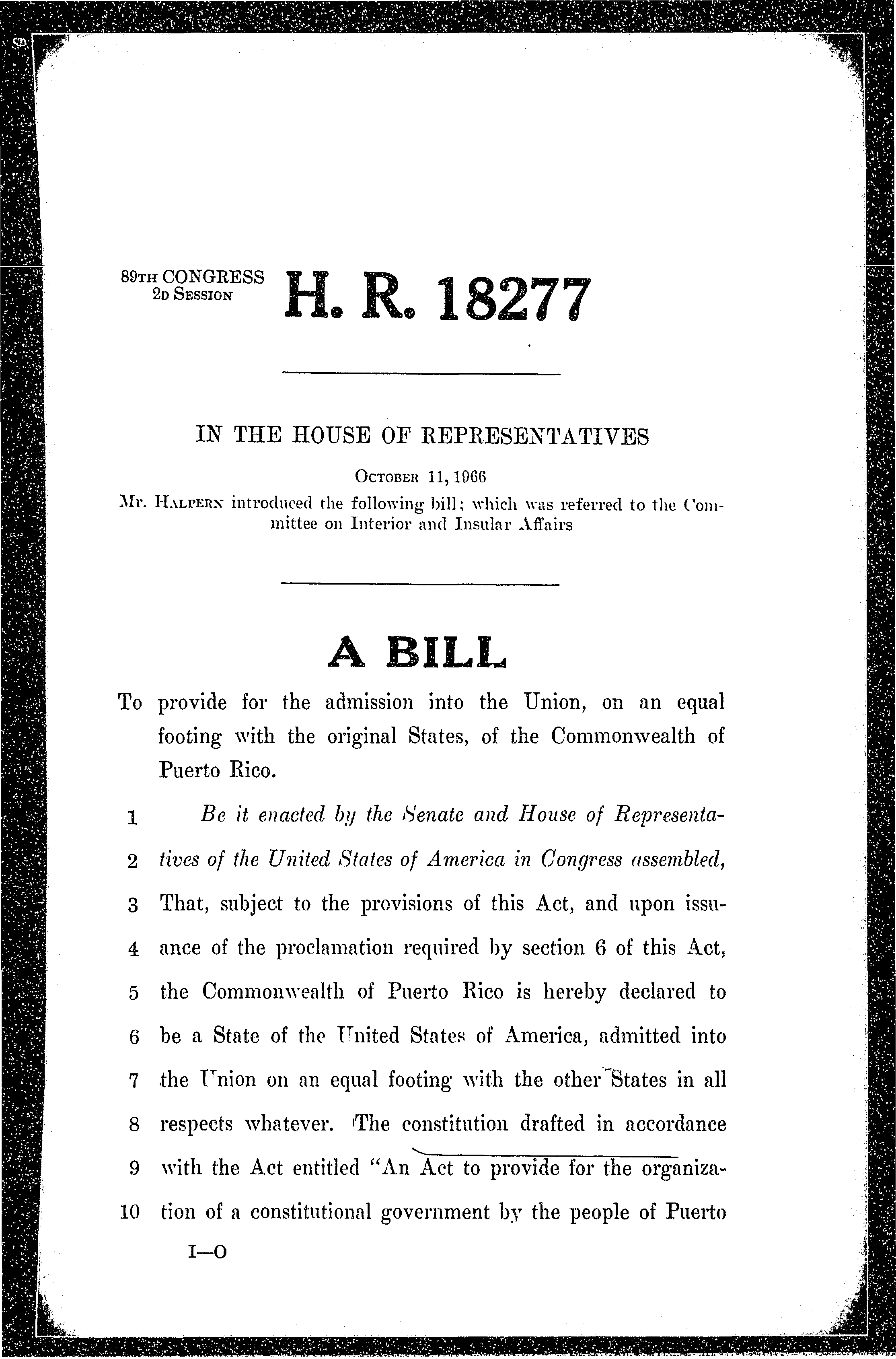
Four plebiscitary bills were introduced during the 109th Congress. Two of the bills were companion bills, namely H.R. 4963 and S. 2304. A third bill, S. 2661, also called for a plebiscite. In contrast, H.R. 4867 called for a two-stage plebiscite, a departure from the latter three bills. The 109th Congress did not enact any status changing legislation for Puerto Rico.
Back To Chapter
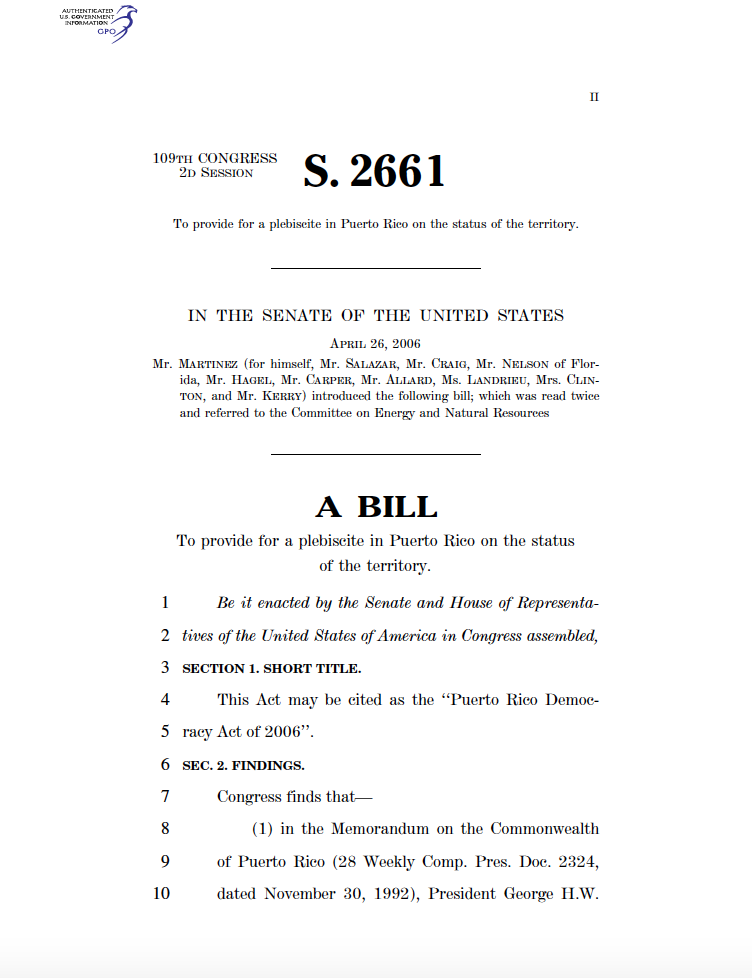
Three bills status bills were introduced during the 67th Congress. Unlike other type of legislation, status bills require Congress to make a determination on the application of one status to Puerto Rico. The first bill introduced in this Congress, H.R.9934, incorporated Puerto Rico as a territory. The latter companion status bills, H.R.9995, and S.3137, were simultaneously introduced in the House and Senate and provided for the creation of an Associate Free State status or a status that granted Puerto Rico an autonomous but subordinated territorial status. To be sure, both bills contained provisions reminiscent of the Platt Amendment provisions used to legitimate any U.S. intervention in an autonomous Puerto Rico.